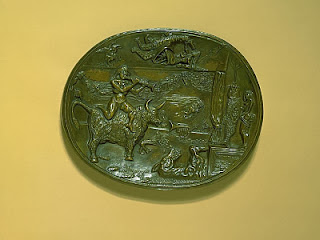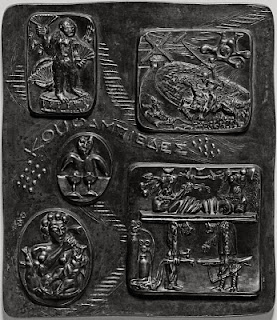I am going to be checking out the
rue Blomet show and some other stuff in a few days before they close up in the Big Sugar Plum but there's noteworthy shows 'round here, like, for instance, the
Princeton Art Museum is cookin'. I am forced against my inclinations (as Piri' Miri Muli' readers know) to lavish praise on
curators all around, like
Eduardo Cadava and Gabriela Nouzeilles' selections for a four-room Latin American photography
survey (right, Pablo Ortiz Monasterio's
And it is silver, cement, or breeze) and the Kelly Baum-curated
New Jersey as Non-Site (til Jan. 5) which combines a generous selection of the Robert Smithson/ Nancy Holt oeuvre related to the Garden State with mementos of Allen Kaprow and Dick Higgins' happenings on and around George Segal's farm, Segal's own works, a whole section of Amiri Baraka in Newark materials proffering the ability to sit down and chill to his jazz collaborations, and, as they say in the two neighboring media markets, much, much more. An excellent film documentation of a late 50s Kaprow happening gives one the impression that the South Brunswick farm is a folly that Segal bought with his art money, but Segal was an aspiring painter yet to turn to sculpture that Kaprow took under his wing, and the farm was being assiduously worked, purchased with the money his parents saved up from their
butcher shop in the Bronx. Segal's
works in the show can be seen by day trippers in tandem with his
Depression Bread Line, the only "sad" work in Seward Johnson's DisneyFrick Happy Land*
(Grounds for Sculpture) where you can analysand it on the couch in Mister Munch's Centrally Heated Screamyland and see sculpture from folks who have happened by Johnson's Atelier. If that's not happy enough there's a great
Trinidian roti shop by GfS's entrance** at Nottingham and Ward.
The Non-Site show's location in Central Jersey means you have to drive through a part of NJ to see it "I do not say walk.. the sane man will want his.. by car. Even if it is by public omnibus. It is not a country
to walk in.." unless you live in the Princeton area. The show prominently features Kaprow's observation
“the New Jersey Turnpike, as it passes through the industrial complex around Newark, is better than art,” and some have already speculated that Smithson was influenced by Tony Smith's 1966 recollection in ArtForum "..in.. the 50's, someone told me how I could get on to the unfinished New Jersey Turnpike.. it did something for me that art had never done. At first I didn't know what it was, but its effect was to liberate me from many of the views I had about art. It seemed that there had been a reality there which had not had any expression in art.. The experience on the road was something mapped out but not socially recognized. I thought to myself, it ought to be clear that's the end of art. Most paintings look pretty pictorial after that..."
(pdf) Some have also speculated that Smithson's earthworks (left,
Line of Wreckage) may have been influenced by Marcos Grigorian, the Armenian from Iran featured in the Asia Society's
Iran Modern show who was creating earthworks, inspired in part by the Holocaust, in New York in the late 50s.
Smithson's explanation of the Non-Site: "The Non-Site ... represents an actual site in New Jersey. It is by this dimensional metaphor that one site can represent another site which does not resemble it - this The Non-Site. To understand this language of sites is to appreciate the metaphor between the syntactical construct and the complex of ideas, letting the former function as a three dimensional picture which doesn't look like a picture. 'Expressive art' avoids the problem of logic; therefore it is not truly abstract. A logical intuition can develop in an entirely 'new sense of metaphor' free of natural or realistic expressive content. Between the actual site in the Pine Barrens and The Non-Site itself exists a space of metaphoric significance. It could be that 'travel' in this space is a vast metaphor. Everything between the two sites could become physical metaphorical material devoid of
natural meanings and realistic assumptions" relates to Piri' Miri Muli' themes (at times
incorporating Smithson) of the interpretation of the visual world - for instance, Chogyam Trungpa's "samsara is the entrance, samsara is the vehicle
for nirvana" preceded immediately by "there is active behavior, then passive, then active.. the first moment producing and giving birth to
the next.." Daumal's wanting
to see Mount Meru was paradoxically an active desire for the passive, while the Smithsonian and Cagean view of the ubiquity of the resonance of the material world was passive in its observation of, active in its recording of, a subject which was both passive and active. Daumal at different times would seem to appear in three points of Deleuze's
Nietzsche and Philosophy schema: as the artist/master, as the top level of reactive
ressentiment (towards Breton) and as the ascetic man, in his devotion to Gurdjieff. Deleuze: "the fiction of a world-beyond in the ascetic ideal.. is what gives the world a value of appearance or of nought.. the ascetic ideal (also expresses) the affinity of reactive forces with nihilism as the 'motor' of reactive forces." Gurdjieff thought that artist should not arrive at meaning unwittingly, differing from
the views of Hegel and Adorno, while Daumal, a year before he met Gurdjieff, wrote about Rimbaud "the object of criticism.. is to show luminously how the poet wrote a necessary corpus of work, bound by a rigorous determinism to the whole of the contemporary world, and supported by a law just as perfectly inflexible.. This freedom, the source of all values is (as Spinoza understands it, and any other meaning is impossible) that of the man who frees himself by thinking of himself as determined by universal
will." In Daumal's schema the active poet is valued over the "useless, sterile, odious" passive poet.
Also the Philly Museum is liberating
a selection of the Surrealist works which were donated to them with good intentions but kept in storage for years so the curators could display inferior works, til March 2. The Imagist poet Walter Arensberg donated his collection along with the Duchamp mausoleum because Philly made the longest contractual commitment to keeping the Large Glass and
Étant donnés on display but gathering dust for years were Duchamp's erotic works, donated by Arensberg, now in storage to make way for Jasper Johns paintings, along with Arensberg's donations of Di Chirico's charcoal
Victorious Love, an etching by Masson, and Leonora Carrington's wonderful etching
The Dogs of the Sleeper (right). There's also a donated Wifredo Lam
(The Spirit of Morning), a donated 1934 painting
The Bullfight by Picasso, both stored til now (I thought Picasso was taught in the art history programs), Kay Sage's
The Unicorns Come Down to the Sea, and a delightful newly acquired Matta
To Escape the Absolute. Elaborating all my pet peeves about Philly culture would take me more than a little time and soul-searching, but one way to make room for good paintings would be to put the
academic paintings in Gallery 155 in storage and stop hanging the works of Van Gogh, Manet, and Courbet in the hallway of all places. The Met has the large academic paintings in the crowded hallway and the important paintings in their own destination rooms. Oh and a teeny weeny
room displaying 16 major Venetian Renaissance paintings
stolen from the John Johnson estate has had the naming rights sold to Arco Chemical Company, and the nice folks at the chemical company apparently are not, as I am, requesting that the works of Titian, Bassano, and Veronese are displayed at eye level, properly in a John Johnson wing. "Properly" doesn't enter into it - Philly would be seen as a cultural beacon only after the Johnson works are returned to a reconstruction of the intended house museum, the Barnes works returned to his estate, with the mediocre boondoggle built for the Barnes works rededicated to become the Museum of the Mafia (I assure you, people would come see that, if they "properly" don't pull punches). Oh, and they decided to
take down the tribute to Albert Barnes, surprise, surprise; oh, and the museum that promised to bring art to the “plain people”
now charges $22, surprise, surprise (I used to pay $1 to get in without a reservation); oh, a Barnes board member now admits they were all lying about the Barnes in Merion having financial problems, how'd they keep that out of the Inquirer and Bulletin. Meanwhile the city is still
broke because the same crooked people are running it. They hired Frank Gehry for the art museum renovation because he's the Most Famous Architect, First Class, Money's No Object but when he (who developed amongst visual artists in LA) unveiled his proposed exterior the board said "Ewww- that's weird, no way!" (the Philly art establishment said the same thing about Barnes' collection before they were told it was worth billions). The Penn alumni, unlike their Princeton counterparts, can't have their collections shown at their alma mater unless they've snuck a ancient artifact home from the Mayan trail because the
death squad
cheerleaders in the anthropology department have successfully kept the art history department away from their gravy train of dusty, empty rooms that haven't seen a thoughtful acquisition in over 40 years, but I won't get into my views on the topic while I look forward to the rue Gramet show and Yuletide carols.
* Frick was known for collecting light works of art. I suppose I would like the Grounds better if Johnson did a three dimensional
Third of May or, as Joan Fontcuberta is featured in the Princeton show, his
Googlegram 5: Abu Ghraib would look good there as a sculpture for photo ops..
** Route 33 only seems to have an exit for northbound though, on your way out. If you're going S, I guess you can take Klockner Rd. N to State Street E
 Three shows of paintings on the Upper East Side this week: James Rosenquist at Feigen (34 East 69th Street, til Jan 10) centers around two large-scale paintings from 1973, but for those (like me) who didn't see the forty foot long version of his Holy Roman Empire Through Checkpoint Charlie at the 2006 Art Dealers Association show, a smaller version is there on lithograph, as well as a 2004 litho of The Xenophobic Movie Director or Our Foreign Policy (right), a selection of other paintings, and Rosenquist-related works by Ray Johnson.
Three shows of paintings on the Upper East Side this week: James Rosenquist at Feigen (34 East 69th Street, til Jan 10) centers around two large-scale paintings from 1973, but for those (like me) who didn't see the forty foot long version of his Holy Roman Empire Through Checkpoint Charlie at the 2006 Art Dealers Association show, a smaller version is there on lithograph, as well as a 2004 litho of The Xenophobic Movie Director or Our Foreign Policy (right), a selection of other paintings, and Rosenquist-related works by Ray Johnson.








